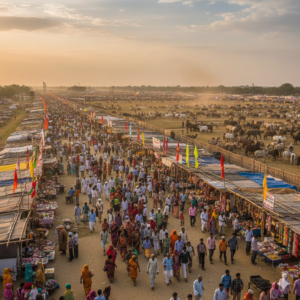The calendar may read 2025, but in a small town in Bihar, a thousand-year-old tradition is unfolding on an epic scale. The Sonepur Mela, or Harihar Kshetra Mela, is more than just a fair; it’s a living piece of Indian history, recognized as Asia’s largest cattle fair. While media often focuses on the chaos, we’re here to appreciate the sheer, vibrant beauty of this massive, open-air bazaar where culture, commerce, and devotion converge.
The Mela’s origin is profoundly spiritual and provides a historical backdrop unmatched by any modern trade show. It takes place specifically at the auspicious confluence of two great Indian rivers, the Ganges (Ganga) and the Gandak. Pilgrims gather on the first full moon (Kartik Purnima, which falls in November) to take a holy dip, believing it washes away sins. This pilgrimage site, Harihar Kshetra, soon evolved into a strategic trading post. Historically, trade here involved war elephants, horses, and various goods, reflecting its importance under ancient empires like the Mauryan.
Today, the market retains its identity as a spectacle. Stretching for miles, the mela grounds buzz with a vibrant, chaotic energy. While the sale of livestock, particularly the famous horses and cows, is the primary economic driver, the fair’s true charm lies in the astonishing diversity of the items and experiences available. It’s a genuine reflection of the rural heartland, where every purchase tells a story of local production and traditional artistry.

The modern consumer’s appreciation for authentic and handcrafted goods makes the Sonepur Mela a unique retail experience. Here, shopping goes far beyond the local mall; it’s an active search for treasures that carry the essence of Indian craftsmanship.
- Folk Arts and Crafts: Artisans set up stalls offering everything from intricate bamboo work and handwoven textiles to traditional agricultural tools and unique pottery.
- Entertainment: The day’s commerce gives way to night-time entertainment that feels utterly traditional, including folk dances, music, and impromptu performance tents that draw crowds from surrounding villages.
The Mela is one of the last places in India where the massive, traditional scale of rural commerce remains untouched by urbanization. It’s a sensory overload of sights, sounds, and smells, a powerful living reminder of India’s economic history before the age of digital marketplaces. It’s a true microcosm of the nation, celebrating community, devotion, and entrepreneurial spirit under the vast Bihari sky.
To witness the Sonepur Mela is to experience an unparalleled spectacle of traditional Indian culture still very much alive. It’s a rewarding, eye-opening experience that few international travelers ever witness.
Dive deeper into India’s incredible cultural heritage by exploring our past articles on iconic festivals and traditions!